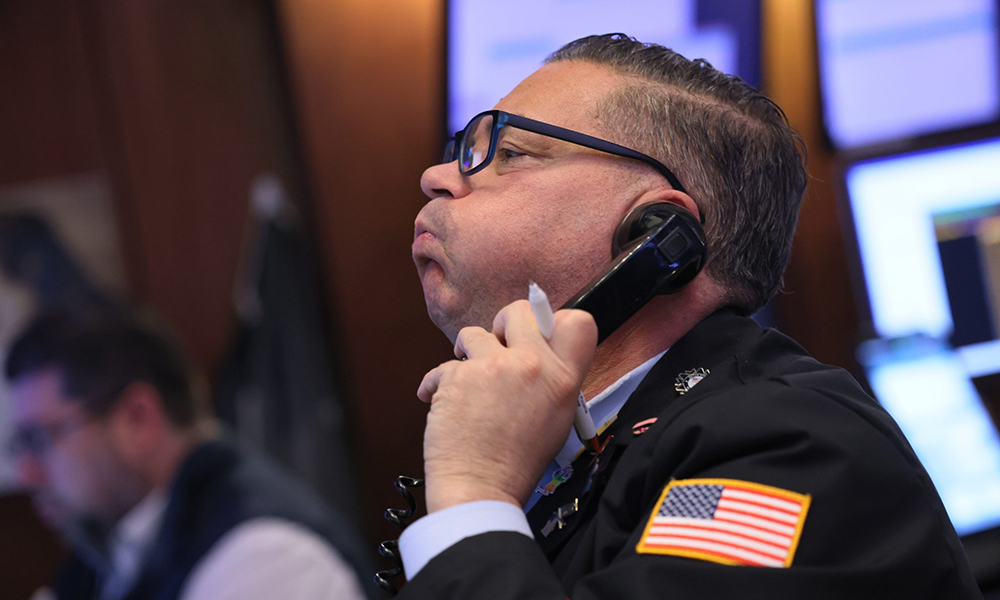
雖然近幾個月甚至是近幾年來,美國不時有頂尖的經(jīng)濟(jì)學(xué)家和華爾街的首席執(zhí)行官預(yù)測美國經(jīng)濟(jì)即將發(fā)生衰退,但美國消費者硬是憑著強(qiáng)大的購買力讓他們的預(yù)測一次又一次落空。盡管美國面臨著近40年來最嚴(yán)重的惡性通脹,甚至為此不得不連續(xù)加息,但消費者并沒有因此而捂緊錢袋子,美國經(jīng)濟(jì)也因為國內(nèi)消費的活躍而仍然保持堅挺。但是上周的一些不容樂觀的經(jīng)濟(jì)數(shù)據(jù)卻讓部分專家認(rèn)為,這次衰退可能真的要來了。
首先是繼向下修正了1月的零售業(yè)銷售數(shù)據(jù)后,美國2月的零售業(yè)銷售數(shù)據(jù)繼續(xù)呈現(xiàn)疲軟勢頭。這表明在持續(xù)兩年的高通脹和輪番加息的轟炸下,消費者的購買力已經(jīng)呈現(xiàn)疲態(tài)。Federated Hermes公司的投資經(jīng)理達(dá)米安·麥金太爾通過電子郵件對《財富》雜志表示:“上個月的零售業(yè)數(shù)據(jù)下滑或許可以歸咎于天氣原因,但是本月的銷售數(shù)據(jù)疲軟則表明消費者的購買力可能并沒有想象的那么健康。”
與此同時,美國在3月14日發(fā)布的2月生產(chǎn)者價格指數(shù)(PPI)也再度高于華爾街的預(yù)期。PPI一般會帶動消費者價格指數(shù)(CPI)的上漲,因此很多投資者翹首以盼的降息或許不會很快發(fā)生了,尤其是美聯(lián)儲(Federal Reserve)的官員已經(jīng)明確指出,在通脹得到充分控制之前,美聯(lián)儲不打算降息。LPL Financial公司的首席全球策略師昆西·克勞斯比稱:“對于看重數(shù)據(jù)的美聯(lián)儲來說,這份報告對降息顯然沒有任何幫助。”
如果光分析零售業(yè)銷售數(shù)據(jù)和PPI這兩個指標(biāo)本身,你就會發(fā)現(xiàn),它們對整體經(jīng)濟(jì)而言并非什么可怕的信號——零售業(yè)銷量還遠(yuǎn)遠(yuǎn)談不上崩潰,PPI的漲幅也不算很厲害,但其中表現(xiàn)出來的趨勢卻是值得擔(dān)憂的。如果PPI繼續(xù)上漲,企業(yè)很可能就會把上漲的成本轉(zhuǎn)嫁給消費者。那么早已在高通脹下不堪重負(fù)的消費者很可能會就勢“躺平”,不再積極消費,美國經(jīng)濟(jì)或?qū)⒕痛藷o可抑制地滑下衰退的深淵。
不利跡象一:PPI上漲
美國勞工部(Labor Department)的勞工統(tǒng)計局(Bureau of Labor Statistics)于3月14日發(fā)布的美國PPI是一個特別值得關(guān)注的指標(biāo),因為PPI的上漲最容易對整體經(jīng)濟(jì)造成沖擊。PPI反映了美國國內(nèi)企業(yè)生產(chǎn)成本的變化,2月美國的PPI上漲了0.6%,高于經(jīng)濟(jì)學(xué)家們普遍預(yù)測的0.3%。
美國2月的PPI也同比增長了1.6%,不過這遠(yuǎn)低于2023年1月4.7%的同比增幅(當(dāng)時美國的通脹率依舊高達(dá)6%)。雖然今年1月的PPI同比增長率貌似不高,但我們在此再次強(qiáng)調(diào),需要關(guān)注的是它反映出來的趨勢。自2023年10月以來,美國的PPI同比增長率一直保持在1.1%以下,到今年1月也僅有1%。但2月的PPI卻顯然邁向了一個不容樂觀的方向。
今年2月,美國的能源價格上漲了4.4%,這是推動PPI上漲的一個重要因素。2023年美國整體通脹水平下降的一個重要原因是商品通脹的下降。不過花旗銀行(Citi)的經(jīng)濟(jì)學(xué)家維羅妮卡·克拉克認(rèn)為,2月的美國PPI數(shù)據(jù)顯然表明,“美國商品價格的反通脹趨勢基本上已經(jīng)接近尾聲了。”
由于抑制通脹的力量消失了,很多投資者期待已久的降息很可能又要被擱置,除非接下來即將發(fā)布的CPI較為給力。Commonwealth Financial Network公司的高級股票策略師羅布·斯萬克表示:“總的來說,這可能會導(dǎo)致美聯(lián)儲在接下來的幾次會議上繼續(xù)擱置降息問題。”
不利跡象二:零售業(yè)銷量疲軟
隨著PPI的上漲,2月美國的零售業(yè)銷售數(shù)據(jù)弱于預(yù)期,這也給美國整體經(jīng)濟(jì)帶來了狠狠一擊。
根據(jù)美國人口調(diào)查局(Census Bureau)在3月14日公布的數(shù)據(jù),今年2月,美國的零售業(yè)銷售額環(huán)比僅增長0.6%,同比僅增長1.5%,低于經(jīng)濟(jì)學(xué)家普遍預(yù)測的環(huán)比增長0.8%。盡管汽油價格有所上漲,各大汽車廠商也采取了各種促銷措施吸引消費者購車,但數(shù)據(jù)顯示,消費者還是捂緊了錢袋子。
Bankrate公司的高級行業(yè)分析師泰德·羅斯曼在3月14日通過電子郵件指出:“1.5%的同比增長率是不值一提的,甚至還不到整體CPI漲幅的一半。換句話說,零售業(yè)的銷售數(shù)據(jù)已經(jīng)滯后于通脹數(shù)據(jù)了。對零售商而言,經(jīng)濟(jì)已經(jīng)進(jìn)入一個緩慢增長階段,只有電商、餐飲、酒吧等行業(yè)的年度增長數(shù)據(jù)高于總體通脹數(shù)據(jù)。”
除了2月的零售業(yè)銷售數(shù)據(jù)弱于預(yù)期,1月的零售業(yè)銷售數(shù)據(jù)的同比漲幅也從之前的-0.8%修正為-1.1%。這也標(biāo)志著此前公布的PPI指數(shù)連續(xù)四個月需要下調(diào)。
LPL Financial公司的首席經(jīng)濟(jì)學(xué)家杰弗里·羅奇通過電子郵件告訴《財富》雜志:“這些經(jīng)濟(jì)指標(biāo)連續(xù)數(shù)月進(jìn)行向下修正,恰恰說明了經(jīng)濟(jì)增長正在放緩。”盡管目前美國的失業(yè)率仍舊維持在低位,消費者也還有一些消費能力,但經(jīng)濟(jì)下行的大趨勢已經(jīng)顯現(xiàn)出來。
在這兩個不利跡象接連出現(xiàn)后,有哪些嚴(yán)重后果是投資者們最應(yīng)該擔(dān)心的?首先是信用卡違約問題值得關(guān)注,今年美國的信用卡債務(wù)已經(jīng)再創(chuàng)歷史新高。另外羅奇指出:“接下來幾個月,汽車銷量也是一個值得關(guān)注的指標(biāo)。如果美國經(jīng)濟(jì)確實進(jìn)入下行階段,那么預(yù)計汽車庫存就會大幅增加,經(jīng)銷商也會出臺更多的促銷措施。”(財富中文網(wǎng))
譯者:樸成奎
雖然近幾個月甚至是近幾年來,美國不時有頂尖的經(jīng)濟(jì)學(xué)家和華爾街的首席執(zhí)行官預(yù)測美國經(jīng)濟(jì)即將發(fā)生衰退,但美國消費者硬是憑著強(qiáng)大的購買力讓他們的預(yù)測一次又一次落空。盡管美國面臨著近40年來最嚴(yán)重的惡性通脹,甚至為此不得不連續(xù)加息,但消費者并沒有因此而捂緊錢袋子,美國經(jīng)濟(jì)也因為國內(nèi)消費的活躍而仍然保持堅挺。但是上周的一些不容樂觀的經(jīng)濟(jì)數(shù)據(jù)卻讓部分專家認(rèn)為,這次衰退可能真的要來了。
首先是繼向下修正了1月的零售業(yè)銷售數(shù)據(jù)后,美國2月的零售業(yè)銷售數(shù)據(jù)繼續(xù)呈現(xiàn)疲軟勢頭。這表明在持續(xù)兩年的高通脹和輪番加息的轟炸下,消費者的購買力已經(jīng)呈現(xiàn)疲態(tài)。Federated Hermes公司的投資經(jīng)理達(dá)米安·麥金太爾通過電子郵件對《財富》雜志表示:“上個月的零售業(yè)數(shù)據(jù)下滑或許可以歸咎于天氣原因,但是本月的銷售數(shù)據(jù)疲軟則表明消費者的購買力可能并沒有想象的那么健康。”
與此同時,美國在3月14日發(fā)布的2月生產(chǎn)者價格指數(shù)(PPI)也再度高于華爾街的預(yù)期。PPI一般會帶動消費者價格指數(shù)(CPI)的上漲,因此很多投資者翹首以盼的降息或許不會很快發(fā)生了,尤其是美聯(lián)儲(Federal Reserve)的官員已經(jīng)明確指出,在通脹得到充分控制之前,美聯(lián)儲不打算降息。LPL Financial公司的首席全球策略師昆西·克勞斯比稱:“對于看重數(shù)據(jù)的美聯(lián)儲來說,這份報告對降息顯然沒有任何幫助。”
如果光分析零售業(yè)銷售數(shù)據(jù)和PPI這兩個指標(biāo)本身,你就會發(fā)現(xiàn),它們對整體經(jīng)濟(jì)而言并非什么可怕的信號——零售業(yè)銷量還遠(yuǎn)遠(yuǎn)談不上崩潰,PPI的漲幅也不算很厲害,但其中表現(xiàn)出來的趨勢卻是值得擔(dān)憂的。如果PPI繼續(xù)上漲,企業(yè)很可能就會把上漲的成本轉(zhuǎn)嫁給消費者。那么早已在高通脹下不堪重負(fù)的消費者很可能會就勢“躺平”,不再積極消費,美國經(jīng)濟(jì)或?qū)⒕痛藷o可抑制地滑下衰退的深淵。
不利跡象一:PPI上漲
美國勞工部(Labor Department)的勞工統(tǒng)計局(Bureau of Labor Statistics)于3月14日發(fā)布的美國PPI是一個特別值得關(guān)注的指標(biāo),因為PPI的上漲最容易對整體經(jīng)濟(jì)造成沖擊。PPI反映了美國國內(nèi)企業(yè)生產(chǎn)成本的變化,2月美國的PPI上漲了0.6%,高于經(jīng)濟(jì)學(xué)家們普遍預(yù)測的0.3%。
美國2月的PPI也同比增長了1.6%,不過這遠(yuǎn)低于2023年1月4.7%的同比增幅(當(dāng)時美國的通脹率依舊高達(dá)6%)。雖然今年1月的PPI同比增長率貌似不高,但我們在此再次強(qiáng)調(diào),需要關(guān)注的是它反映出來的趨勢。自2023年10月以來,美國的PPI同比增長率一直保持在1.1%以下,到今年1月也僅有1%。但2月的PPI卻顯然邁向了一個不容樂觀的方向。
今年2月,美國的能源價格上漲了4.4%,這是推動PPI上漲的一個重要因素。2023年美國整體通脹水平下降的一個重要原因是商品通脹的下降。不過花旗銀行(Citi)的經(jīng)濟(jì)學(xué)家維羅妮卡·克拉克認(rèn)為,2月的美國PPI數(shù)據(jù)顯然表明,“美國商品價格的反通脹趨勢基本上已經(jīng)接近尾聲了。”
由于抑制通脹的力量消失了,很多投資者期待已久的降息很可能又要被擱置,除非接下來即將發(fā)布的CPI較為給力。Commonwealth Financial Network公司的高級股票策略師羅布·斯萬克表示:“總的來說,這可能會導(dǎo)致美聯(lián)儲在接下來的幾次會議上繼續(xù)擱置降息問題。”
不利跡象二:零售業(yè)銷量疲軟
隨著PPI的上漲,2月美國的零售業(yè)銷售數(shù)據(jù)弱于預(yù)期,這也給美國整體經(jīng)濟(jì)帶來了狠狠一擊。
根據(jù)美國人口調(diào)查局(Census Bureau)在3月14日公布的數(shù)據(jù),今年2月,美國的零售業(yè)銷售額環(huán)比僅增長0.6%,同比僅增長1.5%,低于經(jīng)濟(jì)學(xué)家普遍預(yù)測的環(huán)比增長0.8%。盡管汽油價格有所上漲,各大汽車廠商也采取了各種促銷措施吸引消費者購車,但數(shù)據(jù)顯示,消費者還是捂緊了錢袋子。
Bankrate公司的高級行業(yè)分析師泰德·羅斯曼在3月14日通過電子郵件指出:“1.5%的同比增長率是不值一提的,甚至還不到整體CPI漲幅的一半。換句話說,零售業(yè)的銷售數(shù)據(jù)已經(jīng)滯后于通脹數(shù)據(jù)了。對零售商而言,經(jīng)濟(jì)已經(jīng)進(jìn)入一個緩慢增長階段,只有電商、餐飲、酒吧等行業(yè)的年度增長數(shù)據(jù)高于總體通脹數(shù)據(jù)。”
除了2月的零售業(yè)銷售數(shù)據(jù)弱于預(yù)期,1月的零售業(yè)銷售數(shù)據(jù)的同比漲幅也從之前的-0.8%修正為-1.1%。這也標(biāo)志著此前公布的PPI指數(shù)連續(xù)四個月需要下調(diào)。
LPL Financial公司的首席經(jīng)濟(jì)學(xué)家杰弗里·羅奇通過電子郵件告訴《財富》雜志:“這些經(jīng)濟(jì)指標(biāo)連續(xù)數(shù)月進(jìn)行向下修正,恰恰說明了經(jīng)濟(jì)增長正在放緩。”盡管目前美國的失業(yè)率仍舊維持在低位,消費者也還有一些消費能力,但經(jīng)濟(jì)下行的大趨勢已經(jīng)顯現(xiàn)出來。
在這兩個不利跡象接連出現(xiàn)后,有哪些嚴(yán)重后果是投資者們最應(yīng)該擔(dān)心的?首先是信用卡違約問題值得關(guān)注,今年美國的信用卡債務(wù)已經(jīng)再創(chuàng)歷史新高。另外羅奇指出:“接下來幾個月,汽車銷量也是一個值得關(guān)注的指標(biāo)。如果美國經(jīng)濟(jì)確實進(jìn)入下行階段,那么預(yù)計汽車庫存就會大幅增加,經(jīng)銷商也會出臺更多的促銷措施。”(財富中文網(wǎng))
譯者:樸成奎
The mighty American consumer has shrugged off months, even years of recession predictions from top economists and Wall Street CEOs. Facing the hottest inflation in 40 years, and aggressive interest rate hikes meant to tame it, consumers have managed to continue spending, enabling the economy to remain on solid footing. But last week, a one-two punch of bad economic data has some experts waiting for another uppercut.
The second straight weak retail sales report, which included a downward revision of January’s sales data, has sparked concerns that consumers are finally showing signs of wear and tear after powering through price increases and rising borrowing costs for roughly two years. “While last month’s retail sales miss was chalked up to weather, this month’s weakness suggests that perhaps the consumer is not as healthy as expected,” Damian McIntyre, portfolio manager at Federated Hermes, told Fortune in emailed comments.
At the same time, producer price inflation, which tends to lead consumer price inflation, also came in above Wall Street’s expectations for the second straight month on March 14. It’s another piece of data that could put investors’ dreams of swift, economy-boosting interest rate cuts on hold, particularly with Fed officials being very clear that they don’t plan on cutting rates until inflation is well under control. As Quincy Krosby, chief global strategist for LPL Financial, put it: “For the data dependent Fed, this report isn’t helpful.”
The latest retail sales and producer price inflation reports aren’t dire news for the economy in their own right—retail sales are far from outright collapsing, and producer price inflation isn’t soaring—but the new trends seen in them are concerning. If businesses continue to see price hikes, they’ll likely pass those on to already inflation-weary consumers. That could put a stopper on consumers’ aggressive spending, which has helped prevent a U.S. recession so far.
The Jab: Rising Producer Prices
The quick jab that hit the economy first on March 14 was an elevated producer price inflation reading. The producer price index (PPI), which measures the change in the prices domestic sellers pay, rose 0.6% last month, the Labor Department’s Bureau of Labor Statistics reported on March 14. That was compared to economists’ consensus forecast for 0.3%.
Year-over-year, producer prices also jumped 1.6% in February. That’s well below the 4.7% year-over-year rise in producer prices seen in February 2023, when inflation was still at 6%, but once again it’s the trend that’s concerning. After sticking at or below 1.1% since October, including just 1% in January, February’s PPI inflation data is a step in the wrong direction.
Producers’ inflation was largely driven by a 4.4% spike in energy prices in February that caused overall goods prices to rise. Falling goods inflation has been one of the keys to the drop in overall U.S. inflation over the past year, but for Citi economist Veronica Clark, the PPI report is evidence that “the disinflation in goods prices is largely coming to an end.”
The end of goods disinflation is apt to put interest rate cuts, which many investors were expecting to see this month not long ago, on hold unless upcoming consumer price inflation reports prove more favorable. “Overall…this likely continues to provide support for the Fed remaining on pause for the next few meetings,” Rob Swanke, senior equity strategist for Commonwealth Financial Network, said.
The Cross: Weak Retail Sales
After being touched up by a producer price index jab, the economy was hit with a serious right cross from a weaker-than-expected retail sales report.
Retail sales rose just 0.6% month-over-month and 1.5% from a year ago in February, the Census Bureau reported on March 14. That’s compared to economists’ consensus forecast for an 0.8% monthly rise in sales. Even with rising gas prices and car dealer incentives driving more spending, the data shows consumers are beginning to rein in their budgets.
“The 1.5% year-over-year gain is minimal and less than half of the headline CPI number. In other words, retail sales are lagging inflation,” Ted Rossman, senior industry analyst at Bankrate, told reporters in emailed comments on March 14. “It’s a slow-growth economy for retailers, with only e-commerce shops and bars and restaurants posting annual growth figures above the overall rate of inflation.”
On top of the slower than forecast February data, last month’s year-over-year sales figures were revised down from negative 0.8% to negative 1.1%. That marks the fourth consecutive month previous producer inflation data was revised lower.
Jeffrey Roach, chief economist at LPL Financial, told Fortune via email that the “consistent downward revisions should tell us the economy is slowing,” even if the consumer still has some capacity to spend with the unemployment rate remaining low.
What should investors fearing a knockout follow-up punch to the latest one-two be looking for? Credit card delinquencies are one area of concern, with credit card debt reaching a record high this year. But Roach had another idea: “A helpful indicator to watch in the coming months is auto sales. If the economy is truly slowing, expect to see vehicle inventories swell and dealers offer more incentives,” he said.






